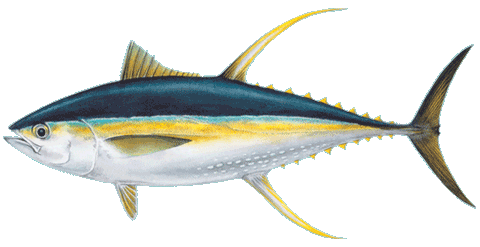Hawaii Deep Sea Fishing FAQ's (OAHU) "NEW Fishing Information For Oahu Sportfishing June 2020"
Where do Oahu fishing charters leave from?
Most Oahu fishing charters will depart from Kewalo Basin in Honolulu (1-2 miles from Waikiki) but some can also depart from Ko Olina on the west side of the island.(35 miles from Waikiki)
Where do most fishing charters go on Oahu?
Most of the sport fishing found on Oahu will be on the leeward coastlines usually departing from Kewalo Basin in Honolulu. Oahu fishermen know these waters well and often will take advantage of the sharp drop-off not far off the coast of Waikiki and head north toward the north-west corner of the island at Kaena Point. This tactic is used to catch the big fish as they swim up from the deep waters of the channel between Kauai and Oahu. Another tact used by experienced fisherman is to reverse course and head to the shallow fishing grounds to the south of Waikiki called "Pinnacles" and another area called "The Penguin Banks." These strategies will be determined based upon the catch of the previous days, reports from other boats and the changing of ocean conditions that may alter the location of fish.
Two other options are to follow the depth curves such as the 1,000 fathom line or head to offshore surface objects such as FADs (Fish Aggregation Devices) "HH", "BO", or "S" which are all well within reach.

What types of fish are caught in Oahu?
The waters around Oahu are home to the Pacific Blue, Sailfish, Striped and Short Billed Marlin, the Skipjack and Yellow Fin Tuna, Mahi-mahi, Wahoo (Ono), Trevally, Shark, Barracuda, and Hawaiian Salmon. These are the same fish you'll find on the dinner menu at your favorite Waikiki seafood restaurant most nights. The largest reported Marlin ever caught (an 1805lb Blue) was caught off of Oahu near Ko'Olina.

Some of the more common fish that are caught in Hawaii are:

Ahi, also called Yellowfin Tuna. Highly prized for flavorful meat – excellent both in sashimi and cooked – as well as the fight when hooked and being landed by the angler, Yellowfin is often sought after by those on our charters. One can easily identify Ahi by the dual dorsal fins and bright yellow finlets along the spine of the fish.

Aku, also called Skipjack Tuna. Difficult to land because of the soft tissues that surround their jaws, Skipjack put up a moderate fight. Their flesh is oily and dark, appealing to those who like the taste of mackerel.

Blue Marlin. The Blue Marlin is highly prized by sport fishers as they put up a great fight when hooked, leading to a battle between human and fish to bring in the Marlin. Blue Marlin are challenging for even those most accomplished at offshore sport fishing and are avidly sought after when we head out.

Mahi Mahi, also called Dorado or Dolphin Fish. A colorful fish, easily identified by the hump on the head, Mahi Mahi is prized for its flesh, which makes for excellent eating. For many people, Mahi Mahi is the fish most closely associated with Hawaii, as it features prominently in the local cuisine.

Ono, also called Wahoo. Usually caught through trolling, Ono are related to mackerel but do not school, in contrast to other mackerel species. Wahoo are characterized by a slender and tube-like face and mouth, they also have a slender and long body shape.

Sailfish. An incredible fish, which is highly prized by anglers because of the fight it puts up once hooked, the Sailfish is characterized by the massive leaps and jumps it makes when being landed. Easily identified by a massive dorsal fin, sports fishers have long sought out this fish and landing a Sailfish leads to many, many stories told by the lucky angler.

Striped Marlin The Striped Marlin is occasionally caught in the Atlantic Ocean but is more often landed in the Indian and Pacific Oceans. The Striped Marlin is visually stunning, with vertical blue stripes on the sides which appear vibrant when it is excited or during the fight to land it. It also has a pointed, high dorsal fin, which makes it easy to identify.
OAHU SEA CONDITIONS:
Water Depths (feet)

Sea Currents

FAD's (Fish Aggregation Devices)
The State of Hawaii has placed Fish Aggregating Devices (FADs) in the waters surrounding the main Hawaiian Islands. These buoys attract schools of tuna and other important pelagic fishes, such as dolphinfish (Mahimahi), wahoo (Ono), and billfish. FADs allow fishermen to easily locate and catch these species.

Sea Surface Heights

Mahalo,
Hawaii Deep Sea Fishing